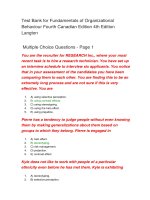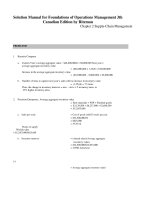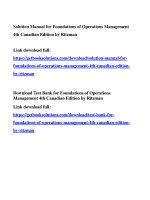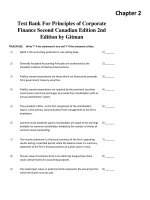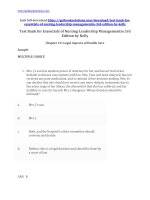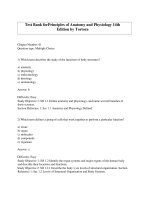Test bank for foundations of operations management 4th canadian edition by ritzman
Bạn đang xem bản rút gọn của tài liệu. Xem và tải ngay bản đầy đủ của tài liệu tại đây (362.97 KB, 51 trang )
Test Bank for Foundations of Operations Management 4th Canadian Edition by
Ritzman
Link download full: />Download Solution Manual for Foundations of Operations Management 4th
Canadian Edition by Ritzman
Link full: />Chapter 2: Supply Chain Management
2.1 End-of-Chapter Problems
1) Supply-chain management is the synchronization of a firm's processes and those
of its suppliers to match the flow of materials, services, and information with
customer demand.
Answer: TRUE
Diff: 1 Type: TF
Reference: Introduction
2) Inventory is a stock of material used to satisfy customer demand or support the
production of goods and services.
Answer: TRUE
Diff: 1 Type: TF
Reference: Measures of Supply-Chain Performance
3) Work-in-process inventory is considered an input to the transformation
processes of the firm.
Answer: FALSE
Diff: 1 Type: TF
Reference: Measures of Supply-Chain Performance
4) The finished goods of one firm may actually be the raw materials for another
firm.
Answer: TRUE
Diff: 1 Type: TF
Reference: Measures of Supply-Chain Performance
1
5) Backward integration describes the practice of gaining control over supplies by
acquiring a controlling interest in one or more of a company's major suppliers.
Answer: TRUE
Diff: 1 Type: TF
Reference: Measures of Supply-Chain Performance
6) Manufacturing firms typically enter into contracts with Tier 2 suppliers with the
expectation that these suppliers will then incorporate the guidelines of these
contracts into the agreements they in turn enter into with Tier 1 suppliers.
Answer: FALSE
Diff: 1 Type: TF
Reference: Measures of Supply-Chain Performance
7) The order-fulfillment process involves the activities to deliver a product or
service to the customer.
Answer: TRUE
Diff: 1 Type: TF
Reference: Measures of Supply-Chain Performance
8) Forward placement is a reduction in inventory and safety stock because of the
merging of variable demands from customers.
Answer: FALSE
Diff: 1 Type: TF
Reference: Measures of Supply-Chain Performance
9) Forward placement means locating stock closer to the manufacturing facility.
Answer: FALSE
Diff: 1 Type: TF
Reference: Measures of Supply-Chain Performance
10) Vendor-managed inventories are an example of the forward placement tactic.
Answer: TRUE
Diff: 1 Type: TF
Reference: Supplier Relationship Process
11) Postponement is a tactic used by mass-customization firms to delay the
customization of a product or service until the last possible moment.
Answer: TRUE
Diff: 1 Type: TF
Reference: Supply Chain Strategies
2
12) Make-to-stock firms tend to use the postponement tactic.
Answer: FALSE
Diff: 1 Type: TF
Reference: Supply Chain Strategies
13) The most used form of e-purchasing today is electronic data interchange.
Answer: TRUE
Diff: 1 Type: TF
Reference: Supplier Relationship Process
14) An electronic marketplace where buying and selling firms come together to do
business is called a catalog hub.
Answer: FALSE
Diff: 1 Type: TF
Reference: Supplier Relationship Process
15) Green purchasing involves identifying, assessing, and managing the flow of
environmental waste and finding ways to reduce it and minimize its impact on the
environment.
Answer: TRUE
Diff: 1 Type: TF
Reference: Supplier Relationship Process
16) The competitive orientation to supplier relations is that the buyer and supplier
are partners.
Answer: FALSE
Diff: 1 Type: TF
Reference: Supplier Relationship Process
17) Sole sourcing is the awarding of a contract for an item or service to only one
supplier.
Answer: TRUE
Diff: 1 Type: TF
Reference: Supplier Relationship Process
3
18) Sole sourcing of an item is never a good tactic.
Answer: FALSE
Diff: 1 Type: TF
Reference: Supplier Relationship Process
19) Value analysis is a systematic effort to reduce the cost or improve the
performance of products or services.
Answer: TRUE
Diff: 1 Type: TF
Reference: Supplier Relationship Process
20) In presourcing, suppliers are selected early in the concept development stage.
Answer: TRUE
Diff: 1 Type: TF
Reference: Supplier Relationship Process
21) Inventory turnover is obtained by dividing the average aggregate inventory
value by sales per week at cost.
Answer: FALSE
Diff: 1 Type: TF
Reference: Measures of Supply-Chain Performance
22) The percentage of incomplete orders shipped is a performance measure for the
purchasing process of supply chain management.
Answer: FALSE
Diff: 1 Type: TF
Reference: Measures of Supply-Chain Performance
23) Responsive supply chains work best with predictable demand.
Answer: FALSE
Diff: 1 Type: TF
Reference: Supply Chain Strategies
24) Responsive supply chains work best when frequent product introduction exists.
Answer: TRUE
Diff: 1 Type: TF
Reference: Supply Chain Strategies
25) Efficient supply chains work best when contribution margins are high.
Answer: FALSE
Diff: 1 Type: TF
4
Reference: Supply Chain Strategies
26) Efficient supply chains work best when product variety is low.
Answer: TRUE
Diff: 1 Type: TF
Reference: Supply Chain Strategies
5
27) Efficient supply chains use low capacity cushions.
Answer: TRUE
Diff: 1 Type: TF
Reference: Supply Chain Strategies
28) Efficient supply chains aggressively try to shorten lead time.
Answer: FALSE
Diff: 1 Type: TF
Reference: Supply Chain Strategies
29) A common disruption of the external supply chain is product and service mix
changes.
Answer: TRUE
Diff: 1 Type: TF
Reference: Supply Chain Strategies
30) A common disruption of the external supply chain is engineering changes.
Answer: FALSE
Diff: 1 Type: TF
Reference: Supply Chain Strategies
31) A common disruption of the internal supply chain is information errors.
Answer: TRUE
Diff: 1 Type: TF
Reference: Supply Chain Strategies
32) The bullwhip effect is the general tendency toward increasing variation in
demand and inventory levels as you move further away from the end customer in
the supply chain.
Answer: TRUE
Diff: 1 Type: TF
Reference: Supply Chain Strategies
33) Because of the bullwhip effect, ordering patterns in supply chains typically
show less variance the further upstream you move in the supply chain.
Answer: FALSE
Diff: 1 Type: TF
Reference: Supply-Chain Dynamics
34) Internal and external disruptions in the supply chain typically result in higher
variability as you move upstream in the supply chain.
6
Answer: TRUE
Diff: 1 Type: TF
Reference: Supply-Chain Dynamics
35) Relative to centralized buying, localized buying has the advantage of
increasing purchasing clout.
Answer: FALSE
Diff: 1 Type: TF
Reference: Supplier Relationship Process
7
36) Centralized purchasing is more likely to be followed for commodity-based
purchases than for specialized parts and services.
Answer: TRUE
Diff: 1 Type: TF
Reference: Supply-Chain Dynamics
37) A cooperative orientation to supplier relations views negotiations between
buyer and seller as a zero-sum game.
Answer: FALSE
Diff: 1 Type: TF
Reference: Supplier Relationship Process
38) The extreme situation of a cooperative orientation to supplier relations is sole
sourcing.
Answer: TRUE
Diff: 1 Type: TF
Reference: Supplier Relationship Process
39) Offshoring is a supply chain strategy that involves moving processes to another
country.
Answer: TRUE
Diff: 1 Type: TF
Reference: Supplier Relationship Process
40) Postponement is an organizational concept whereby members of the
distribution channel are used as if they were assembly stations in the factory.
Answer: FALSE
Diff: 1 Type: TF
Reference: Supplier Relationship Process
41) In presourcing, suppliers are selected early in the concept-development stage.
Answer: TRUE
Diff: 1 Type: TF
Reference: Supplier Relationship Process
42) A catalog hub is a central distribution point where buyers may purchase items
directly from manufacturers before the items are shipped to retailers.
Answer: FALSE
Diff: 1 Type: TF
Reference: Supplier Relationship Process
8
43) Green purchasing involves identifying, assessing, and managing the flow of
environmental waste and finding ways to reduce it and minimize its impact on the
environment.
Answer: TRUE
Diff: 2 Type: TF
Reference: Supplier Relationship Process
44) A cross-docking warehouse holds inventory from manufacturers until retailers
are prepared to sell the items.
Answer: FALSE
Diff: 1 Type: TF
Reference: Supplier Relationship Process
45) The supplier relationship process focuses on the interaction of the firm and
upstream suppliers.
Answer: TRUE
Diff: 2 Type: TF
Reference: Supplier Relationship Process
46) Purchasing power determines the clout that a firm has.
Answer: TRUE
Diff: 1 Type: TF
Reference: Supplier Relationship Process
47) The order fulfillment process produces and delivers the service or product to
the firm's customers.
Answer: TRUE
Diff: 1 Type: TF
Reference: Order Fulfillment Process
48) The performance of a logistics process is indirectly linked to its capacity and
variability of demand.
Answer: FALSE
Diff: 1 Type: TF
Reference: Supply-Chain Dynamics
49) The customer relationship process addresses the interface between the supplier
and its customers downstream in the supply chain.
Answer: FALSE
Diff: 1 Type: TF
Reference: Supply-Chain Dynamics
9
50) Customer service is an important point of contact between the firm and its
customers.
Answer: TRUE
Diff: 1 Type: TF
Reference: Supply-Chain Dynamics
51) The new service or product development process is a core process that
fundamentally shapes the supply chain.
Answer: TRUE
Diff: 1 Type: TF
Reference: Supply-Chain Dynamics
52) The basic purpose of supply chain management is to
A) create an exclusive set of suppliers who will not supply your competitors.
B) link your customers together so that the flow of materials remains under
control.
C) synchronize the operations of all suppliers with those of purchasing, production,
distribution, and customers.
D) reduce the inventory by proper selection of customers and transportation
modes.
Answer: C
Diff: 1 Type: MC
Reference: Introduction
10
53) Which one of the following is TRUE for supply chain management?
A) Supply chain concept applies to both manufacturing and service organizations.
B) Supply chain applies only to manufacturing because it deals with flow of
materials.
C) Supply chain is about suppliers and does not include distributors or customers.
D) Supply chain includes any operation that deals with materials.
Answer: A
Diff: 1 Type: MC
Reference: Introduction
54) Which one of the following statements on inventory placement of finished
goods is best?
A) Forward placement might help reduce transportation cost.
B) Forward placement is consistent with a competitive priority that calls for
customization.
C) Inventory pooling should be avoided when demand in various regions fluctuates
month to month.
D) Backward placement is consistent with a competitive priority that calls for fast
delivery times.
Answer: A
Diff: 2 Type: MC
Reference: Measures of Supply-Chain Performance
55) The practice of locating stock closer to customers at a warehouse, distribution
centre, wholesaler, or retailer is referred to as
A) inventory pooling.
B) vendor managed inventories.
C) forward placement.
D) channel assembly.
Answer: C
Diff: 2 Type: MC
Reference: Measures of Supply-Chain Performance
56) The practice of having the supplier monitor inventory levels at its customer and
replenishing the stock as needed to avoid shortages is referred to as
A) continuous replenishment vendor-managed inventory.
B) inventory pooling.
C) channel assembly of vendor-managed inventory.
D) forward placement.
Answer: A
Diff: 2 Type: MC
11
Reference: Measures of Supply-Chain Performance
57) For improving the efficiency and productivity of a complex supply chain, a
company should do which of the following?
A) Never adopt backward vertical integration.
B) Enter into agreements with first-tier suppliers, and let them manage their
suppliers.
C) Adopt backward vertical integration or enter into agreements with first-tier
suppliers.
D) Adopt backward vertical integration, but avoid writing agreements with firsttier suppliers.
Answer: C
Diff: 2 Type: MC
Reference: Measures of Supply-Chain Performance
12
58) Which one of the following statements is TRUE about purchasing?
A) Purchasing must satisfy the firm's long-term supply needs.
B) Purchasing's primary role should be placing and tracking orders.
C) Purchasing's primary role is to negotiate lower prices.
D) Purchasing's primary role is to negotiate prices and delivery dates.
Answer: A
Diff: 2 Type: MC
Reference: Measures of Supply-Chain Performance
59) Which one of the following statements regarding supplier selection criteria is
TRUE?
A) Suppliers should be selected on the basis of price only because the cost of
materials is a significant portion of total product cost.
B) Suppliers should be selected on the basis of quality, price, and delivery.
C) Suppliers should be selected primarily on the basis of the shortest lead time
because higher lead time increases the cost of inventory.
D) Suppliers should be selected on the basis of quality because quality is always
the most important characteristic of a product.
Answer: B
Diff: 2 Type: MC
Reference: Measures of Supply-Chain Performance
60) Which one of the following statements is TRUE about a cooperative
orientation in supplier relationships?
A) It cannot be implemented in Western countries because competitive bidding is
more effective in that culture.
B) It cannot be implemented in the Western countries because it always benefits
the supplier.
C) It requires all parts and subassemblies to be purchased from the same supplier.
D) It requires few suppliers for each item or service.
Answer: D
Diff: 2 Type: MC
Reference: Supplier Relationship Process
61) One of the benefits of a cooperative orientation in supplier relationships is
A) the buyer sometimes suggests ways to improve the supplier's operations.
B) the supplier implements its own quality standards.
C) the buyer does not have to share much information with the supplier.
D) the supplier has complete freedom in choosing the delivery time.
Answer: A
Diff: 2 Type: MC
13
Reference: Supplier Relationship Process
62) Which one of the following statements is TRUE about a competitive
orientation in supplier relationships?
A) It tends to emphasize short-term advantages over long-term commitments.
B) The supplier gains repeatability and can move toward a line flow process.
C) The supplier is obliged to offer the lowest possible price every time.
D) The supplier is obliged to deliver the material in the shortest possible time,
every time.
Answer: A
Diff: 2 Type: MC
Reference: Supplier Relationship Process
63) Which one of the following statements is TRUE?
A) A buying firm should always adopt a competitive orientation for a standard
item with high demand.
B) Single sourcing is always desirable for high demand items.
C) Long-term contracts are consistent with a cooperative orientation to supplier
relationships.
D) The buyer always wins in a competitive orientation to supplier relationships.
Answer: C
Diff: 2 Type: MC
Reference: Supplier Relationship Process
64) Which one of the following statements correctly represents a benefit of
centralized buying?
A) Local managers have more control over their business.
B) Purchases and production schedules are meshed more easily.
C) Purchasing lead times may be shorter.
D) Increased buying power can result in significant savings in purchasing costs.
Answer: D
Diff: 2 Type: MC
Reference: Supplier Relationship Process
65) Some manufacturers and service providers want to measure the performance of
supply chain by the percentage of on-time deliveries. The main reason for this
measure is
A) it will discourage the competitors to enter the market.
B) it measures the satisfaction levels of suppliers.
C) increased on-time delivery increases revenue by inducing customers to buy
more products from the firm.
14
D) it helps accounting to debit customers' accounts promptly.
Answer: C
Diff: 2 Type: MC
Reference: Measures of Supply-Chain Performance
66) Which one of the following statements about the relation between financial and
supply chain performance measures is TRUE?
A) Longer delivery times require higher levels of working capital.
B) Shorter new product development time decreases revenue.
C) Higher inventory turns call for higher working capital requirement.
D) Lower aggregate inventory value means higher current assets.
Answer: A
Diff: 2 Type: MC
Reference: Measures of Supply-Chain Performance
67) Of the following measures of supply chain performance, which is likely to
have the most direct and measurable impact on a company's financial performance
based on the reduction in the level of working capital required?
A) percentage of suppliers' deliveries received on time
B) percentage of incomplete orders shipped
C) customer satisfaction with the order-fulfillment process
D) time required to fulfill orders
Answer: D
Diff: 3 Type: MC
Reference: Measures of Supply-Chain Performance
68) Which of the following statements does NOT represent a positive link between
supply chain performance and the financial status of a firm?
A) Lowering the cost of purchased materials reduces the level of working capital
required and has a positive impact on the contribution margin.
B) Reduced inventory levels result in an increase in the percentage of partial orders
shipped and an increased inventory turnover ratio.
C) Percentage of orders shipped on time reduces the level of working capital
required and supports increased sales.
D) Reducing supplier lead times reduces the level of working capital required.
Answer: B
Diff: 2 Type: MC
Reference: Measures of Supply-Chain Performance
69) Last year, CMS Enterprises had total inventories (raw materials, work-inprocess, and finished goods) of $5.5 million. During this same year the cost of
15
goods sold was $22 million. The company operates 52 weeks per year. What is the
total inventory (measured as weeks of supply) held by CMS Enterprises last year?
A) less than or equal to 10 weeks of supply
B) greater than 10 but less than or equal to 12 weeks of supply
C) greater than 12 but less than or equal to 14 weeks of supply
D) greater than 14 weeks of supply
Answer: C
Diff: 2 Type: MC
Reference: Measures of Supply-Chain Performance
70) Henderson Corporation is a supplier of alloy ball bearings to auto
manufacturers in Windsor. Because of the specialized manufacturing process
employed, considerable work-in-process and raw material inventories are created.
The current inventory levels are $1,152,000 and $2,725,000, respectively. In
addition, finished goods inventory is $3,225,000, and sales (at cost) for the current
year are expected to be about $24 million. The inventory turnover that Henderson
Corporation is currently expecting is
A) less than 2.0.
B) greater than or equal to 2.0 but less than 2.5.
C) greater than or equal to 2.5 but less than 3.0.
D) greater than or equal to 3.0.
Answer: D
Diff: 2 Type: MC
Reference: Measures of Supply-Chain Performance
16
71) Maple Leaf, Inc., a television manufacturer, would like to reduce its inventory.
To this end, you are asked by the operations manager to assess its inventory level.
You have the following information on inventories from last year's financial
statement:
Raw materials $2,500,000
Work-in-process $1,000,000
Finished goods $ 800,000
In addition, the cost of goods sold last year (50 weeks) was $15 million. What was
the inventory turnover?
A) less than or equal to 2
B) greater than or equal to 2 but less than 3
C) greater than or equal to 3 but less than 4
D) greater than or equal to 4
Answer: C
Diff: 2 Type: MC
Reference: Measures of Supply-Chain Performance
72) The average inventory at Hamilton Industries, comprising raw materials, workin-process, and finished goods, was found to be $17.2 million last year. If the cost
of goods sold per week averaged $1.32 million, what was the inventory turnover
experienced by Hamilton Industries? Assume the company had 50 working weeks
per year.
A) less than or equal to 3.50
B) greater than or equal to 3.50 but less than 3.75
C) greater than or equal to 3.75 but less than 4.00
D) greater than or equal to 4.00
Answer: C
Diff: 2 Type: MC
Reference: Measures of Supply-Chain Performance
73) Efficient supply chain would be preferred when
A) product variety is high.
B) competitive priority is customization.
C) demand is highly predictable.
D) demand is unpredictable.
Answer: C
Diff: 2 Type: MC
Reference: Supply Chain Strategies
74) The type of goods for which efficient supply chain is appropriate is
A) high product cost.
17
B) frequent design changes.
C) high contribution margin.
D) standardized products.
Answer: D
Diff: 2 Type: MC
Reference: Supply Chain Strategies
18
75) Responsive supply chains would be preferred when
A) product variety is low.
B) demand is predictable.
C) contribution margins are low.
D) product variety is high.
Answer: D
Diff: 2 Type: MC
Reference: Supply Chain Strategies
76) The type of goods for which a responsive supply chain is appropriate are
A) fashion goods.
B) products with a long shelf life.
C) expensive products.
D) those with infrequent design changes.
Answer: A
Diff: 3 Type: MC
Reference: Supply Chain Strategies
77) A firm in the higher echelon of an efficient supply chain is likely to have
A) high-capacity utilization.
B) low inventory turns.
C) high-capacity cushions.
D) a flexible flow process.
Answer: A
Diff: 2 Type: MC
Reference: Supply Chain Strategies
78) It is desirable for a firm in the higher echelon of an efficient supply chain to
have
A) high-capacity cushions.
B) delivery by air.
C) a line flow process.
D) high inventory investment.
Answer: C
Diff: 2 Type: MC
Reference: Supply Chain Strategies
79) It is recommended that a firm in the higher echelon of an efficient supply chain
have
A) delivery by air.
B) high-capacity cushions.
19
C) low inventory investments.
D) low-capacity utilization.
Answer: C
Diff: 2 Type: MC
Reference: Supply Chain Strategies
20
80) Firms in a responsive supply chain are expected to have
A) long delivery times.
B) high inventory investments.
C) flexible flow process.
D) low-capacity cushions.
Answer: C
Diff: 3 Type: MC
Reference: Supply Chain Strategies
81) It is desirable for a firm in a responsive supply chain to have
A) low-capacity cushions.
B) delivery by railroad.
C) high-capacity utilization consistent with high-volume delivery.
D) low inventory investments consistent with fast delivery times.
Answer: D
Diff: 2 Type: MC
Reference: Supply Chain Strategies
82) It is recommended that a firm in a responsive supply chain have
A) volume flexibility.
B) flexible quality policy.
C) standardized product.
D) low-capacity cushion.
Answer: A
Diff: 2 Type: MC
Reference: Supply Chain Strategies
83) The objective of a firm in a responsive supply chain is likely to be realized if it
has a
A) standardized product.
B) short lead time.
C) low-capacity cushion.
D) line flow process.
Answer: B
Diff: 2 Type: MC
Reference: Supply Chain Strategies
84) One source of disruption caused by the internal supply chain is
A) forecast error.
B) underfilled shipments.
C) volume changes.
21
D) late deliveries.
Answer: A
Diff: 2 Type: MC
Reference: Supply-Chain Dynamics
22
85) One source of disruption caused by the external supply chain is
A) product or sales promotions.
B) new product or service introduction.
C) late deliveries.
D) engineering changes.
Answer: C
Diff: 2 Type: MC
Reference: Supply-Chain Dynamics
86) Possible causes of disruption due to internal supply chain are
A) late deliveries.
B) machine breakdowns or inexperienced workers.
C) product and service mix changes.
D) underfilled shipments.
Answer: B
Diff: 2 Type: MC
Reference: Supply-Chain Dynamics
87) The general tendency toward increasing variation in demand and inventory
levels as we move further away from the end customer in the supply chain is
referred to as
A) internally generated shortages.
B) bullwhip effect.
C) capacity cushions.
D) continuous replenishment.
Answer: B
Diff: 2 Type: MC
Reference: Supply-Chain Dynamics
88) The tactic of packing products on incoming shipments so that they can be
easily sorted and shipped out of intermediate warehouses in a supply chain is
referred to as
A) channel assembly.
B) cross docking.
C) vendor managed inventory.
D) inventoried pooling.
Answer: B
Diff: 1 Type: MC
Reference: Order Fulfillment Process
89) The phenomenon in supply chains whereby ordering patterns show increasing
23
variances the further upstream you move in the supply chain is referred to as
A) inventory pooling.
B) postponement.
C) forward placement.
D) bullwhip effect.
Answer: D
Diff: 2 Type: MC
Reference: Supply-Chain Dynamics
24
90) What term do we use for a company arranging payments to suppliers and
distributors to provide needed services and materials in order to perform those
processes the organization does not perform itself?
A) backward integration
B) forward integration
C) outsourcing
D) system design
Answer: C
Diff: 2 Type: MC
Reference: Supply-Chain Dynamics
91) Which of the following is an advantage of the postponement technique?
A) reduction in automation
B) better quality of the product
C) reduction in training costs
D) reduction in inventory investment
Answer: D
Diff: 2 Type: MC
Reference: Supply Chain Strategies
92) Which of the following best describes vendor managed inventory?
A) There is minimal purchasing-oriented paperwork.
B) The supplier maintains the inventory for the buyer.
C) The supplier delivers only what the customer needs.
D) There is only one supplier for all units of a particular product.
Answer: B
Diff: 2 Type: MC
Reference: Order Fulfillment Process
93) Which one of the following is TRUE for supply chain management?
A) Supply chain is about suppliers and does not include distributors or customers.
B) Supply chain applies only to manufacturing because it deals with flow of
materials.
C) Supply chain applies to both manufacturing and service organizations.
D) Supply chain includes any operation that deals with materials.
Answer: C
Diff: 2 Type: MC
Reference: Supply Chain Strategies
94) Which of the following changes would decrease the likelihood of the bullwhip
effect?
25
